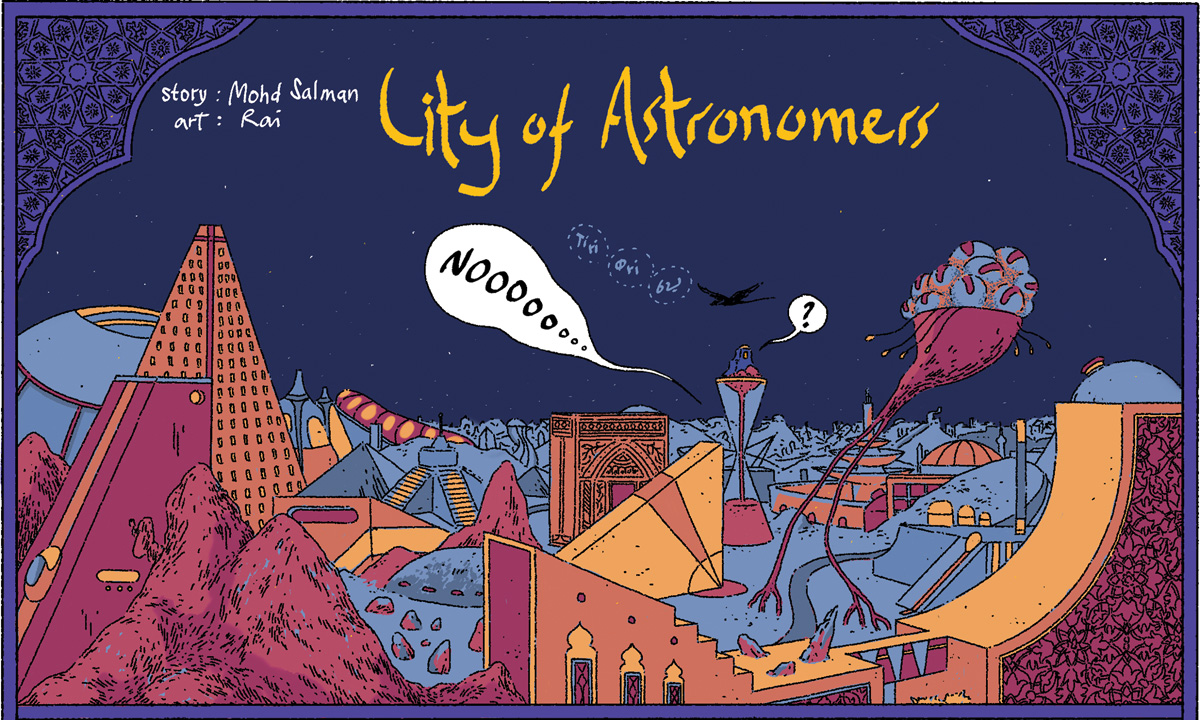
Vol 1 Issue 1 | April-June 2021
City of Astronomers
Story by Mohd Salman | Art by Rai
The earliest humans faced an inescapable darkness every day, when the sun went down. They spent some of those dark hours looking at the sky. Our ancestors looked at the solitary journeys of the Morning Star and the Evening Star, and the millions of others dusted across the heavens in between. They learned that every night was not the same, looking up at clear skies and cloudy skies, full moons and new moons.
As time passed by, they began to see patterns. They learned to calculate time beyond the lengths of day and night. They saw stars that helped them navigate. They began to foretell the change of seasons. The night sky twinkled knowledge at them, and they devoured it.
From mapping solstices to naming the planets, discovering the earth’s curvature and eventually escaping into space, humanity’s relationship with the sky has evolved to keep pace with its advancements.
Fascinating as it is, the earth ties us down with gravity. It is vast but its landmasses have boundaries, as do the seas. Up in the skies, these lines disappear. The possibilities are endless.
“Space is big. You just won’t believe how vastly, hugely, mind-bogglingly big it is. I mean, you may think it’s a long way down the road to the drug store, but that’s just peanuts to space.”
– Douglas Adams
In City of Astronomers, Mohd Salman and Rai have imagined a place where all the astronomers in history get to exist together. We saw (or rather imagined) what Ulugh Beg and Ptolemy would talk about. How do you think the others would interact?
To help you, we’ve put some information together. May the skies open their secrets for you, as they have done for so many others before.
The Aboriginal People of Australia
The Aboriginal and Torres Strait Islander people developed a number of practical ways to observe the Sun, Moon and stars to inform navigation, calendars, and predict weather. Australia’s First Nations people assign meaning and agency to astronomical phenomena, which informs Law and social structure. It also serves as the foundation for narratives that are passed down the generations through song, dance, and oral tradition over tens of thousands of years.
http://www.aboriginalastronomy.com.au/
Ptolemy
Claudius Ptolemy was a Greco-Roman mathematician, astronomer, geographer, astrologer, and a poet of a single epigram in the Greek Anthology. He lived in the city of Alexandria in the Roman province of Egypt, wrote in Koine Greek, and held Roman citizenship.
http://tonsoffacts.com/26-awesome-and-interesting-facts-about-ptolemy/
The Incas
Machu Picchu appears to lie at the center of a network of related sites and trails—and many landmarks both man-made and mountainous appear to align with astronomical events like the solstice sunset. The Inca had no written language, so they left no record of why they built the site or how they used it before it was abandoned in the early 16th century.
https://www.nationalgeographic.com/travel/world-heritage/article/machu-picchu
Jantar Mantar
Between 1724 and 1730 Maharajah Sawaii Jai Singh II of Jaipur constructed five astronomical observatories in northern India. The observatories, or “Jantar Mantars” as they are commonly known, incorporate multiple buildings of unique form, each with a specialized function for astronomical measurement. These structures with their striking combinations of geometric forms at large scale have captivated the attention of architects, artists, and art historians worldwide.
https://www.jantarmantar.org/
Ulugh Beg
The Ulugh Beg Observatory is an astronomical observatory located on a hill near Samarkand, in modern-day Uzbekistan. This observatory, which is often considered to be one of the finest of its kind in the medieval Islamic world, was constructed during the 15th century when Samarkand was one of the two most important cities of the mighty Timurid Empire.
https://www.youtube.com/watch?v=pGmy8Qpy9QY
The history of the telescope
The telescope is one of humankind’s most important inventions. The simple device that made far away things look near gave observers a new perspective. But the identity of the ingenious mind who invented the telescope remains a mystery. Although the invention changed humankind’s perspective of the universe forever, It was probably inevitable that as glassmaking and lens-grinding techniques improved in the late 1500s, someone would hold up two lenses and discover what they could do.
https://ia800209.us.archive.org/15/items/ABriefHistoryOfTheTelescope/Telescope-ABriefHistoryOfTheTelescope-2009-gonick.pdf
https://www.space.com/21950-who-invented-the-telescope.html
Annie Jump Cannon
Annie Jump Cannon was a pioneering astronomer responsible for the classification of hundreds of thousands of stars. She studied physics and astronomy at Wellesley College and went on to work at Harvard Observatory. A trailblazer for women in science, she discovered hundreds of variable stars and devised a unique system of classification that became the universal standard, in which she listed hundreds of thousands of stars.
https://www.youtube.com/watch?v=scqKVhLcWQc
https://www.youtube.com/watch?v=QxOepsiQNtE
https://www.biography.com/scientist/annie-jump-cannon
The Arecibo Observatory
The Arecibo Observatory had its origins in an idea of Professor William E. Gordon, from Cornell University, who was interested in the study of the Ionosphere. Gordon’s research during the fifties led him to the idea of radar back scatter studies of the Ionosphere. Gordon’s persistence culminated in the construction of the Arecibo Observatory which began in the summer of 1960.
https://www.naic.edu/ao/history#:~:text=The%20Arecibo%20Observatory%20had%20its,scatter%20studies%20of%20the%20Ionosphere.

